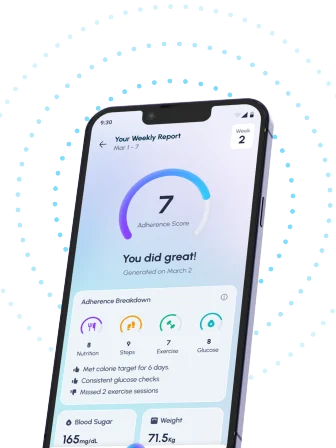Table of Contents
- Unlocking the Power of Low-Glycemic Foods
- Low-Glycemic Index Diet: Benefits & How-To Guide
- What is a Low-Glycemic Diet & its Health Benefits?
- Is a Low-Glycemic Diet Right for You? Find Out Now!
- Managing Blood Sugar: Your Low-Glycemic Diet Plan
- Frequently Asked Questions
- References
Are you ready to unlock the secrets to sustainable weight management and improved energy levels? Then you’ve come to the right place! This blog post dives deep into Unlocking the Power of a Low-Glycemic Index Diet: Benefits and Truths Revealed, exploring the science behind this popular eating approach. We’ll debunk common myths and uncover the surprising benefits a low-GI diet can offer, from stabilizing blood sugar to boosting overall health. Get ready to learn how to harness the power of food to transform your well-being!
Unlocking the Power of Low-Glycemic Foods
Understanding the Glycemic Index (GI)
The glycemic index (GI) measures how quickly a carbohydrate-containing food raises blood sugar levels. Low-GI foods, those digested and absorbed slowly, lead to a more gradual and sustained rise in blood glucose, preventing the sharp spikes associated with high-GI foods. This is particularly crucial in regions like India and other tropical countries, where over 75% of people with diabetes reside in low- and middle-income countries. Managing blood sugar effectively is vital for preventing long-term complications.
Benefits of a Low-GI Diet in Tropical Climates
A low-GI diet offers numerous advantages, especially in hot, humid climates prevalent across many Indian and tropical regions. These diets often incorporate plenty of fresh fruits, vegetables, and legumes, naturally abundant in these regions. This helps regulate blood sugar, aiding in weight management and potentially reducing the risk of type 2 diabetes and its related complications, including heart disease. The emphasis on whole, unprocessed foods can also contribute to better overall health and well-being. For further insights into enhancing the benefits, explore Discover How Fermented Foods Help Regulate Blood Glucose Levels.
Practical Tips for a Low-GI Lifestyle
Incorporating a low-GI diet into your daily routine can be simple. Choose whole grains like brown rice and millets over refined grains. Select legumes such as lentils and chickpeas which are dietary staples in many Indian and tropical cuisines. Prioritize fruits and vegetables, particularly those lower on the GI scale, like berries and leafy greens. Remember to consume carbohydrates with protein and healthy fats to slow down glucose absorption. Learning effective Cooking Techniques to Lower Glycemic Impact can significantly improve your results.
Embrace a Healthier Future
Adopting a low-GI diet is a powerful step toward better health, especially considering the high prevalence of diabetes in India and tropical countries. By making smart food choices and incorporating these simple tips, you can significantly improve your blood sugar control and overall well-being. Let’s work together to build a healthier future for our communities.
Low-Glycemic Index Diet: Benefits & How-To Guide
Understanding the Glycemic Index (GI)
Many people in India and other tropical countries struggle with managing blood sugar levels. A significant concern is the high prevalence of diabetes; studies show HbA1c levels above 9% in over 30% of diabetic patients. This highlights the urgent need for effective blood sugar management strategies. A low-glycemic index (GI) diet can be a powerful tool in this fight. The GI ranks carbohydrates based on how quickly they raise blood sugar. Foods with a low GI cause a slower, more gradual rise, preventing the blood sugar spikes associated with high-GI foods like refined sugars and white bread, commonly consumed across many Indian and tropical cuisines.
Benefits of a Low-GI Diet in Tropical Climates
Adopting a low-GI diet offers several key advantages. It helps in better blood sugar control, reducing the risk of complications associated with diabetes, like heart disease and nerve damage. For individuals living in tropical climates, where heat can exacerbate certain health conditions, a low-GI diet can also provide sustained energy, preventing fatigue. It also aids in weight management, which is crucial in combating the rise of obesity-related health problems prevalent in these regions. This approach focuses on incorporating whole grains, legumes, and plenty of non-starchy vegetables common in many regional cuisines. Choosing the right fruits can be key, and you can learn more about Low Glycemic Index Fruits to help you plan your meals.
Practical Steps to Implement a Low-GI Diet
Transitioning to a low-GI diet doesn’t require drastic changes; it’s about making smart substitutions. Replace white rice with brown rice or quinoa, and refined flour with whole wheat flour. Prioritize fresh fruits and vegetables, which are abundant and diverse in many tropical regions. Include healthy fats like those found in nuts, seeds, and avocados, further enhancing the nutritional profile of your meals. Remember to consult with a doctor or registered dietitian before making significant dietary changes, especially if you have pre-existing health conditions.
Embracing a Healthier Lifestyle
By incorporating a low-GI diet rich in locally sourced, fresh produce, you can significantly improve your health outcomes and enhance your overall well-being. Let’s make healthier choices together, starting today! If you’re considering a low-carb approach, it’s helpful to understand the differences; check out this article comparing dietary strategies: Low-Carb vs. Moderate-Carb Diets for Diabetes: What Works Best? Contact your local healthcare professional to discuss how to tailor a low-GI diet to suit your specific needs and preferences.
What is a Low-Glycemic Diet & its Health Benefits?
A low-glycemic index (GI) diet focuses on foods that cause a slower, more gradual rise in blood sugar levels. This is crucial, especially in regions like India and other tropical countries where diets often include high amounts of readily digestible carbohydrates. Understanding the GI is key to managing blood sugar and reducing the risk of long-term health complications. Daily consumption of sugary beverages, for example, raises diabetes risk by 26%, highlighting the importance of mindful food choices. A low-GI approach helps mitigate this risk.
Understanding Glycemic Index
The glycemic index ranks carbohydrates based on how quickly they raise blood glucose levels. Low-GI foods (55 or less) are digested and absorbed more slowly, leading to a more stable blood sugar level. This helps prevent energy crashes and insulin spikes, promoting sustained energy throughout the day. In hot climates, maintaining stable energy levels is vital for productivity and overall well-being.
Benefits of a Low-GI Diet in Tropical Climates
Adopting a low-GI diet offers numerous benefits, particularly in tropical regions. It can help manage weight, improve insulin sensitivity (crucial for diabetes prevention), and reduce the risk of heart disease. Focusing on whole grains, legumes, and plenty of fruits and vegetables with a low GI is essential. Think of incorporating traditional Indian staples like moong dal or rajma, which are naturally low-GI options. This approach promotes a healthy gut microbiome, too, contributing to better overall health. Managing blood sugar effectively can also contribute to Nutritional Strategies for Lowering Triglycerides, a common concern related to metabolic health.
Getting Started with a Low-GI Diet
Start by gradually incorporating more low-GI foods into your daily meals. Replace refined carbohydrates like white rice and sugary drinks with healthier alternatives like brown rice, oats, and fresh fruit juices. Consult a nutritionist or healthcare professional for personalized advice tailored to your specific needs and dietary preferences. Embrace a balanced, low-GI diet for a healthier, more energetic life. Remember that maintaining a healthy weight and blood sugar levels are important factors in overall health, and can even help support healthy blood pressure levels.
Is a Low-Glycemic Diet Right for You? Find Out Now!
Understanding your blood sugar levels is crucial, especially in regions like India and other tropical countries where dietary habits often involve high-glycemic foods. A reading below 5.7% is considered normal; however, levels between 5.7% and 6.4% indicate prediabetes, while 6.5% or higher suggests diabetes. These figures are vital for assessing your personal health needs.
Understanding Glycemic Index (GI)
A low-glycemic index (GI) diet focuses on foods that release glucose slowly into the bloodstream, preventing those dramatic spikes and crashes in blood sugar. This can be particularly beneficial in managing or preventing diabetes, a growing concern across India and many tropical nations. By choosing foods with a low GI, you can experience sustained energy levels throughout the day, rather than the sudden bursts and subsequent energy slumps associated with high-GI meals. Examples of low-GI foods abundant in these regions include lentils, many types of beans, and various non-starchy vegetables.
Benefits Beyond Blood Sugar Control
Beyond diabetes management and prevention, a low-GI diet offers numerous other advantages. It can contribute to improved weight management, reduced risk of heart disease, and potentially even better skin health. This is significant, especially in climates with high humidity where skin issues are more prevalent. Adopting a mindful approach to food choices, focusing on low-GI options readily available in your area, can transform your well-being. For more information on optimizing your diet for glycemic stability, you might find our article on Meal Timing & Intermittent Fasting for Glycemic Stability helpful.
Taking Action
Ready to embark on this transformative journey? Start small. Gradually incorporate more low-GI foods into your daily diet. Consult a nutritionist or healthcare professional familiar with the dietary patterns and needs specific to your region for personalized advice. They can help you design a low-glycemic plan that aligns with your lifestyle and local food availability, making it easier to maintain and benefit from long-term. Another dietary approach to consider, supported by research, is the Mediterranean Diet for Blood Sugar Control.
Managing Blood Sugar: Your Low-Glycemic Diet Plan
Understanding Glycemic Index (GI) in Tropical Climates
Maintaining healthy blood sugar levels is crucial, especially in Indian and tropical countries where dietary habits often include high-carbohydrate foods. A low-glycemic index (GI) diet can be incredibly beneficial. The GI measures how quickly a carbohydrate-containing food raises your blood sugar. Foods with a low GI (generally below 55) cause a slower, more gradual rise, preventing blood sugar spikes. This is particularly important for individuals managing diabetes, where target blood pressure is generally below 140/90 mmHg, although some guidelines recommend aiming even lower, below 130/80 mmHg. Note: Always consult your doctor or a certified diabetologist for personalized advice.
Building Your Low-GI Meal Plan
A low-GI diet isn’t about restriction; it’s about smart choices. Focus on whole, unprocessed foods common in Indian and tropical cuisines: legumes (dal, lentils), vegetables like okra and spinach, and whole grains like brown rice and oats. Incorporate plenty of healthy fats like those found in nuts, seeds, and avocados. Limit refined carbohydrates such as white rice, white bread, and sugary drinks, which have a high GI. Remember, portion control is key, even with low-GI foods. For more information on maintaining healthy blood sugar levels, check out our article on Blood Sugar Levels.
Practical Tips for Success
* Prioritize fiber: Fiber slows down digestion, helping regulate blood sugar.
* Choose lean protein sources: Chicken, fish, and beans help stabilize blood sugar.
* Spice it up: Indian spices like turmeric and cinnamon have potential blood sugar-regulating properties.
* Consult a nutritionist: A professional can tailor a low-GI diet plan specific to your needs and preferences, considering the readily available food options in your region. Building good habits is crucial for long-term success. Learn more about How to Build Habits That Help Control Blood Sugar Levels.
By adopting a low-GI diet tailored to your local food choices, you can effectively manage your blood sugar and enhance your overall health. Speak with your healthcare provider today to discuss how to integrate this approach into your lifestyle.
Frequently Asked Questions on Power of a Low-Glycemic Index Diet
Q1. What is a low-glycemic diet and how does it benefit me?
A low-glycemic diet focuses on foods that cause a slow, steady rise in blood sugar, unlike high-glycemic foods that lead to sharp spikes. This helps prevent energy crashes, aids in weight management, and reduces the risk of type 2 diabetes and related complications like heart disease. It’s particularly beneficial in tropical regions with high diabetes rates.
Q2. How can I easily incorporate a low-glycemic diet into my daily routine?
Start by swapping refined grains (white rice, white bread) for whole grains (brown rice, millets, whole wheat). Choose legumes (lentils, chickpeas), which are dietary staples in many tropical cuisines. Prioritize low-GI fruits (berries) and vegetables (leafy greens). Combine carbohydrates with protein and healthy fats to slow down glucose absorption.
Q3. What are the key advantages of a low-glycemic diet, especially in tropical climates?
In hot, humid climates, a low-GI diet offers sustained energy, preventing fatigue. It regulates blood sugar, aiding weight management and reducing the risk of diabetes and its complications. The emphasis on whole, unprocessed foods promotes better overall health and well-being.
Q4. Are there any potential challenges or limitations to a low-glycemic diet?
Transitioning to a low-GI diet might require some adjustments to your eating habits. It’s crucial to plan your meals thoughtfully and ensure you are still getting a balanced intake of nutrients. Consulting a doctor or registered dietitian is recommended before making significant dietary changes, particularly if you have pre-existing conditions.
Q5. Where can I find more information and support to start a low-glycemic diet?
Consult a doctor or registered dietitian for personalized guidance. They can help create a plan tailored to your needs and local food availability. Numerous online resources and educational materials on low-glycemic diets and managing blood sugar are also available.
References
- A Practical Guide to Integrated Type 2 Diabetes Care: https://www.hse.ie/eng/services/list/2/primarycare/east-coast-diabetes-service/management-of-type-2-diabetes/diabetes-and-pregnancy/icgp-guide-to-integrated-type-2.pdf
- Your Guide to Diabetes: Type 1 and Type 2: https://www.niddk.nih.gov/-/media/Files/Diabetes/YourGuide2Diabetes_508.pdf




